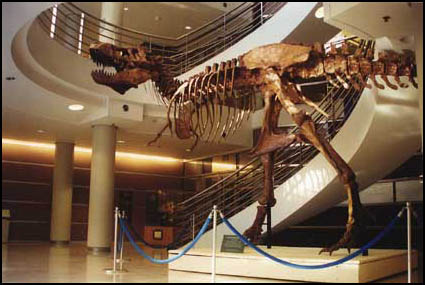Some of the earliest known dinosaurs to have walked the planet were considered to be small dinosaurs like the swift-footed Eoraptor. But researchers have discovered a new dinosaur-like fossil that may be even older. Called Nyasasaurus parringtoni, the specimen is thought to have existed 10 to 15 million years earlier than dinosaur fossils have previously shown, originating in the Middle rather than the Late Triassic Period.
Study lead author Sterling Nesbitt, a University of Washington postdoctoral researcher in biology, said if this “newly named Nyasasaurus parringtoni is not the earliest dinosaur, then it is the closest relative found so far.” His paper is published online today in the Royal Society’s Biology Letters journal.
Paul Barrett, with the Natural History Museum in London, told BBC News that this specimen “fills a gap between what we previously knew to be the oldest dinosaurs and their other closest relatives… There was this big gap in the fossil record where dinosaurs should’ve been present and this fossil neatly fills that gap.”
Nesbitt said scientists have long suggested that dinosaurs should have existed in the Middle Triassic, but there hasn’t been any conclusive proof of that to date. “Some scientists used fossilized footprints, but we now know that other animals from that time have a very similar foot. Other scientists pointed to a single dinosaur-like characteristic in a single bone, but that can be misleading because some characteristics evolved in a number of reptile groups and are not a result of a shared ancestry.”
If the newly named species proves not to be a dinosaur, yet only a close relative, then the Middle Triassic dinosaur theory would still prove inconclusive.
With that being said, the team said they cannot definitively say their new specimen is the earliest known dinosaur due to insufficient material: one upper arm bone and six vertebrae.
The team said it is difficult to sort out the early evolution of dinosaurs because they were so closely related to a variety of reptiles that proliferated at the time. However, the research team, which also included Sarah Werning from the University of California at Berkeley, noticed a few features in the fossil that were distinctive of dinosaurs, notably the “elongated deltopectoral crest” that served as an anchor for strong pectoral muscles.
Nesbitt, who also led a 2010 study that described an animal group—Silesaurs—calling it the dinosaurs’ oldest relative, said based on the fossil fragments described, the team estimates the animal stood upright, was 7 to 10 feet in length, 3 feet tall at the hip, and weighed in the neighborhood of 135 pounds.
The fossil fragments were collected in Tanzania in the 1930s, although it is difficult to say if dinosaurs actually originated in that region. When N. parringtoni was alive, the world’s continents were joined together as one supercontinent called Pangaea. Tanzania would have been part of Southern Pangaea, which included Africa, South America, Antarctica and Australia.
It is safe to say, based on the new fossil description, that dinosaurs’ lineage derived from the southern continents, a region where Archosaurs, one of the earliest animal groups linked to dinosaur evolution, derive, according to the researchers.
This finding “takes dinosaurs back to the right kind of time when those two groups would have split apart from each other,” added Barrett
He explained that during this time, dinosaurs would not have been as dominant as they later became. This would have been an early point in the evolutionary scale for dinosaurs, a time “when lots of reptile groups are evolving,” noted Barrett.
“Dinosaurs start out as a very insignificant group of reptiles – all relatively small animals, relatively rare in comparison with other reptile groups – and it’s only a bit later in their history that they suddenly explode and take over as the dominant forms of life for nearly 100 million years,” he added.
Werning, who conducted the bone analysis for the research, said the bone tissues of N. parringtoni “had a lot of bone cells and blood vessels… In living animals, we only see this many bone cells and blood vessels in animals that grow quickly, like some mammals or birds.”
“The bone tissue of Nyasasaurus is exactly what we would expect for an animal at this position on the dinosaur family tree,” she added. “It’s a very good example of a transitional fossil; the bone tissue shows that Nyasasaurus grew about as fast as other primitive dinosaurs, but not as fast as later ones.”
“Nyasasaurus and its age have important implications regardless of whether this taxon is a dinosaur or the closest relatives of dinosaurs,” Nesbitt said. “It establishes that dinosaurs likely evolved earlier than previously expected and refutes the idea that dinosaur diversity burst onto the scene in the Late Triassic, a burst of diversification unseen in any other groups at that time.”
“Dinosaurs are just part of this archosaur diversification, an explosion of new forms soon after the Permian extinction,” Nesbitt said.
The specimen researchers described came from a collection at the Natural History Museum in London. Four vertebrae from a second specimen, also used in the research, are housed in a museum in Cape Town, South Africa. Funding for the research came from the National Science Foundation (NSF) and the Natural History Museum in London.
While the species name parringtoni is new, the genus name Nyasasaurus is not. The name is derived from Nyasa, a lake in Africa located between Malawi and Tanzania, and saurus, meaning lizard. The genus was named by late paleontologist Alan Charig. The species name parringtoni is in honor of University of Cambridge’s Rex Parrington, who discovered the fossils in the 1930s.
Source: Lawrence LeBlond for redOrbit.com – Your Universe Online













 February 14th, 2013
February 14th, 2013  Riffin
Riffin 





 Some Taunton fossils were found wrapped in newspapers which are also being preserved
Some Taunton fossils were found wrapped in newspapers which are also being preserved
